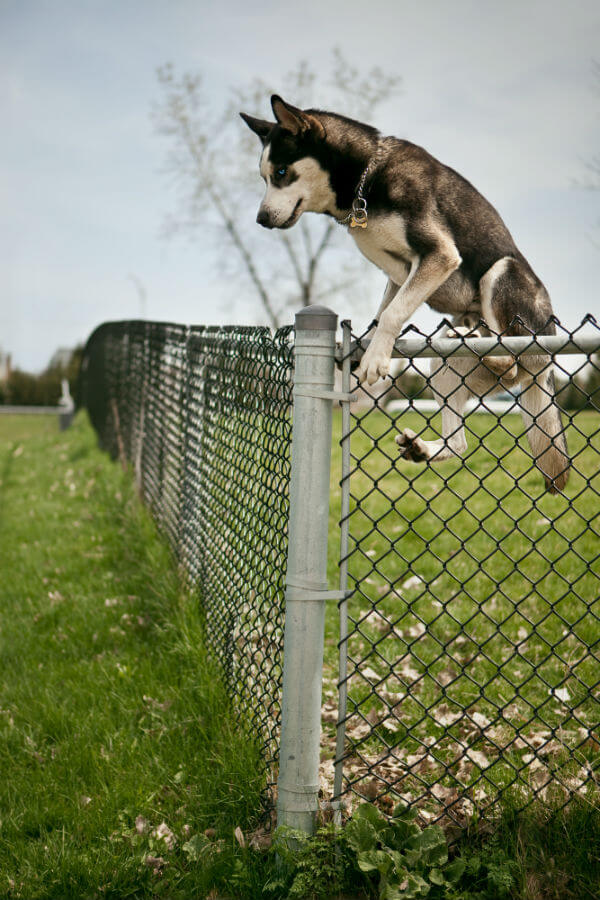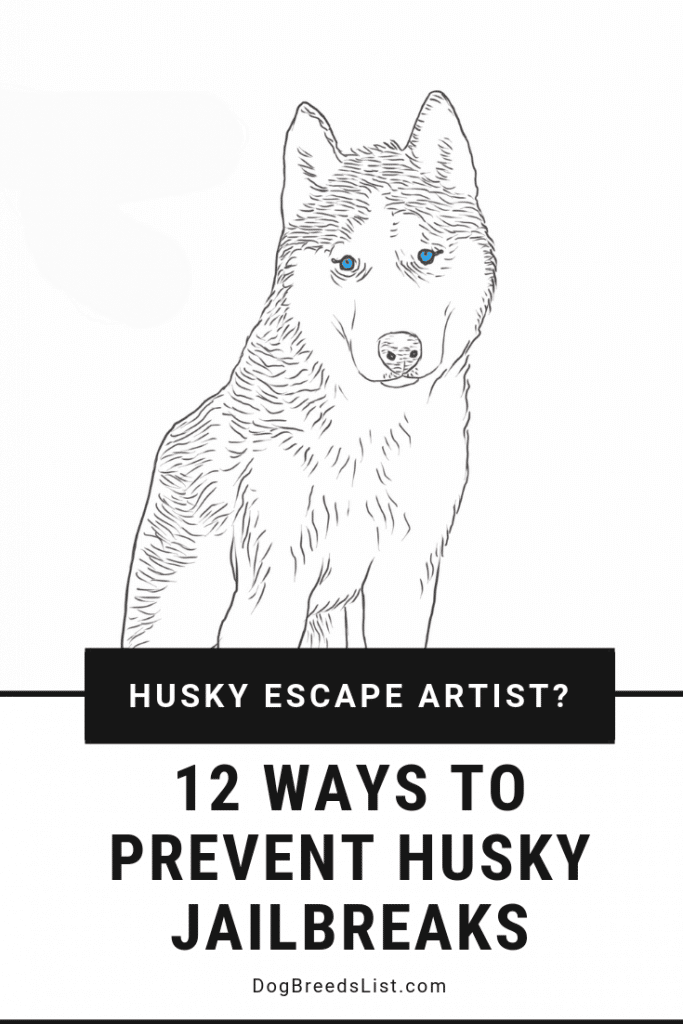Jumping over a gate, digging under a fence, or creating a magician style escape out of a kennel, it seems that Huskies have found any and every way to become an escape artist. If your Husky escapes from their enclosure or your home they may face very serious and dangerous consequences.

After an escape, your dog may be at risk for injury from other animals, vehicles, sharp objects, and toxicity from items they may ingest. Your dog also faces the risk of being lost or unable to be found after being picked up by an animal rescue team.
These are consequences that neither you nor your dog wants to face.
While it may be frustrating to come up with creative solutions to prevent your dog from getting out of their kennel or running out of your yard it is important to take appropriate measures to ensure their safety.
It is also important to determine the root cause and motivation for your dog’s escape so you can provide long term solutions that are effective to prevent future escape attempts.
Reasons for Escapes
Your Husky may be plotting those sneaky escapes due to a variety of reasons:
- Limited Mental Stimulation or Physical Activity (Boredom) – The most common reasons for dog escape attempts. Dogs that have limited daily social and physical interactions with other dogs or people may attempt escapes from enclosures and houses to seek out what they are lacking.
- Territory Protection – Chasing a squirrel or stranger out of their territory could easily go from a snap decision to something much more serious in a matter of seconds.
- Fear – This could include fear of loud noises such as fireworks, construction, or storms. Fear based escapes can also include escapes caused by to separation anxiety.
- Sexual Roaming – When dogs come into sexual maturity it is natural for them to seek out a mate but this may result in unwanted puppies.
- Lack of Social Interaction
- Separation Anxiety
Whatever the reason may be for your Husky’s attempted escape, it’s important to explore and understand the reason for your dog’s escape and to take appropriate measures to prevent future escapes to ensure the safety of your dog.
Below are 12 methods you can use to deter your Husky from escaping again.
Methods to Prevent Husky Escape Attempts
1. Routine Exercise
- Daily Walks
- Dog Park Visits
- Outdoor Playtime
Huskies are a very active breed of dog that requires daily exercise. Taking your dog for daily walks, out to the dog park to play, or providing frequent outdoor playtime can provide your dog with the physical activity they need.
Routine exercise provides both mental stimulation and an outlet to burn off their excess energy.
2. Routine Schedule
Just like people, dogs do well with routine.
It’s helpful to your dog to provide them with a reliable exercise routine. Exercise routines provide consistency so your dog knows they will get play time and exercise time.
They will know when to expect exercise for an outlet to burn off their excess energy instead of seeking out exercise on their own schedule by escaping from their kennel and running around your house.
Scheduling provides structure so your dog knows when it’s time to play and when it is time to be calm.
3. Puzzle Toys
Another common reason for escape is lack of mental stimulation.
Huskies are used to working in packs and used to having a team to interact with. Lack of interaction with other dogs or with people may cause Huskies to act out. This may be their way of seeking out the mental stimulation they need while communicating the message that they are feeling lonely or bored.
Puzzle toys can be a great tool to provide mental stimulation to your buddy.
Kong toys and treat ball toys are great starter puzzle toys for your dog. These toys will provide the mental stimulation that your dog desires along with a yummy treat reward.
4. Doggie Daycare
Doggie daycare is a great resource to use for dogs that need constant exercise or supervision throughout the day.
Doggie daycare can provide an outlet for high energy dogs and can provide mental stimulation and socialization through interaction with other dogs and caretakers. There are many daycare options for your pet that provide customized services for your pet’s unique needs.
Options include:
- All day care with other dogs.
- Personalized care for one dog in your home or a dog sitter’s home.
- Services that let your dog out for walks and potty breaks as requested.
If you can afford it, doggie daycare is a tremendous resource for your peace of mind throughout the day. Your dog will be well cared for, exercised, and not plotting their next escape from their enclosures.
5. Dog Cameras
Dog cameras provide a way to monitor your dog throughout the day. Some options even allow you to speak with your pet and dispense treats to them when you are unable to be home with them.
If your dog is left alone during the day and escapes from their enclosure or home, it may be beneficial to install a dog camera. This can provide answers to how your dog is escaping and can help to develop solutions to prevent future escapes. In case of escape, a dog camera can ensure the safety of your dog to make sure they are not injured or stuck while trying to escape from a kennel.
6. Constant Outdoor Supervision
Other animals and people outdoors provide constant stimuli to your dog and present them with an opportunity that they may feel is just too good to pass up.
Leaving your dog outdoors unsupervised for a few minutes at a time can give them an opportunity to run away, jump over barriers, or dig under a fence in pursuit of another animal or person.
Make sure that your dog is supervised at all times outdoors to avoid a potential runaway situation.
If needed, keep your dog on a leash while outdoors, especially while you are in an unfenced area or public space.
7. Outdoor Space Modifications
Providing a secure outdoor space for your dog, paired with constant outdoor supervision can help to limit avoidable escapes.
A fenced yard that is secured from top to bottom along with a clear space void of any objects that could act as a platform for jumping is vital to for foiling escapes.
Fences and Fence Extensions
If you plan on letting your dog off leash outdoors, secure your outdoor space with a fence.
6-foot fences are the best, but fence extensions are a great option for fences that are not tall enough for high-flying Huskies.
Object Free Fenced in Yard
Your fence line should be clear of any platforms that your dog can jump on to get up and out.
Dog houses, storage boxes, and planters may provide the few extra inches or feet that your dog needs to jump up and over a fence.
If there are objects in your yard, make sure that they are placed at a reasonable distance away from the fence so your dog will not be able to use them as a platform for jumping.
Think High and Low
Dogs are smart and resourceful when it comes to finding a way to get what they want. If they are not able to jump over a fence, they may try to get under the fence.
Perform routine checks of your fence to make sure there are no loose boards, shallow holes dug by other animals, or any potential spots that your dog has already started to dig. The loose board, shallow holes, or attractive digging spots may entice your dog to dig their way out.
If your dog is prone to digging, it is a smart idea to bury chicken wire under the fence line as a second means of security.
8. Circumstantial Protection
Thunder and lightning, fireworks, and loud construction noises are confusing and scary to many dogs.
Fear may cause an instant fight or flight response from your dog. If they choose flight, they could escape in a matter of seconds.
Providing protection for your dog in these scary situations when you can anticipate their occurrence can help to protect your dog from a fear based escape attempt. If you are aware of an incoming storm or holiday fireworks, provide a safe space for your dog to help ease their fears.
Basements or quiet indoor areas can act as a calming, safe space for your pet during stressful situations.
9. Desensitization Training
Many dogs face separation anxiety when their owners leave or they are left alone.
This can be especially true for Huskies that are used to living and working in teams with other dogs and people.
If your dog is especially prone to severe separation anxiety, desensitization training or specialized training can be a helpful tool for your anxious dog.
10. Obedience Classes
From puppy to senior, obedience classes can be a great tool to utilize if your dog is acting out or has undesirable behaviors.
These classes can provide tips and tricks that can help to promote good behavior and limit undesired behavior from your dog.
Classes also provide an opportunity for the social interaction and mental stimulation your dog needs and desires.
11. Spay or Neuter Your Pet
Spay or neuter your pet! Bob Barker has preached this for years!
As a dog comes into sexual maturity it is natural for them to partake in sexual roaming to look for a mate.
In the case of an accidental escape during sexual maturity, spaying or neutering your pet will prevent unwanted puppies that may end up going to an already crowded animal shelter.
12. Microchip
As a last step of protection for your pet it is crucial to get your pet microchipped.
Although you may take extreme measures and precautions to protect your pet from escaping, microchipping provides one last layer of protection.
By microchipping with accurate and up to date information, you are providing critical information about him to potential rescuers.
Runaways picked up by a rescue team have a significantly higher chance of returning home because of proper identification.
Before I Fly the Coop
If your pet escapes an enclosure or returns home after escaping your home, it is very important not to punish your pet. I repeat:
Do not punish your Husky for escaping!
Truthfully, it’s probably your fault. Huskies are a high flight risk and you knew that when you signed on to be a Husky Daddy or Mama.
Punishment doesn’t eliminate the problem and may cause more harm than good to your already fearful dog.
Replace punishment with these steps:
- Ensure that your dog is safe and unharmed.
- Explore potential reasons for the escape.
- Go back through the list above and develop a game plan to prevent future escapes.
If your pet continues to exhibit unwanted behavior and continued attempts to prevent escapes are not working, continue your efforts with a professional dog trainer. They will work with you to develop a training plan that is safe and effective for both you and your pet.
If your dog is showing sign of an injury from an attempted or successful escape, consult your veterinary immediately.
